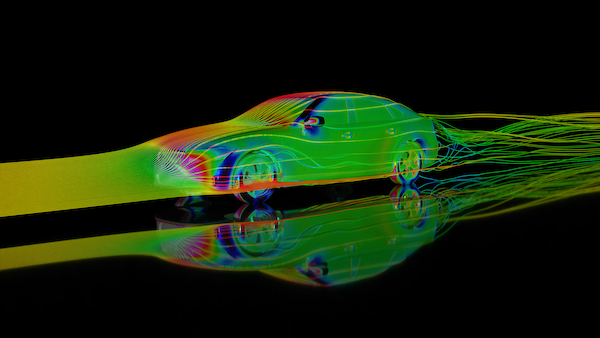Configuring the Right Workstation for Ansys Discovery, Mechanical, and Fluent
Improve simulation performance with NVIDIA RTX™ technology incorporated into an optimized professional workstation.

Image courtesy of Ansys.
Latest News
November 14, 2022
When it comes to leveraging GPU acceleration in its simulation products, Ansys has been an early and enthusiastic adopter, working closely with NVIDIA to ensure faster performance for simulations on Ansys software products including Ansys Discovery, Fluent, Mechanical, and other platforms. By leveraging parallel processing in the GPU, Ansys has been able to rapidly accelerate simulation performance for designers and engineers.
Sunnyvale, CA-based Ozen Engineering is an Ansys Elite Channel Partner that helps its clients achieve unparalleled results from their FEA, CFD, electrical/electronics, and optics and photonics solution investments. We spoke to MingYao Ding, principal and VP of engineering at Ozen, about how to configure a professional engineering workstation for use with Ansys Discovery, Mechanical and Fluent. You can read more about GPU acceleration with Ansys in this blog, and you can learn more about NVIDIA RTX technology gains for Ansys Discovery and Ansys Fluent in this video.
When running these Ansys simulation products,what do you recommend for the workstation GPU?
MD: We typically discuss the specific usage case with the customer before suggesting a GPU. For our CFD and Discovery customers, we suggest the NVIDIA RTX™ A4000 or above. For larger models or very serious simulations, we recommend the NVIDIA RTX™ A6000. This is because our CFD and Discovery simulation tools have been developed from the ground up to effectively leverage GPU computing.
What do you typically recommend for the Ansys products when it comes to CPUs?
MD: Our team typically uses 12- to 32-core workstations. However once an engineer gets used to a 32-core workstation, it is hard to move down to a 12- or 16-core system. Ansys simulation tools use many different techniques to take advantage of HPC, from domain decomposition to frequency splitting. We’ve found 32-core systems to be effective for models up to tens of millions of elements in CFD and degrees of freedom in Mechanical and Electromagnetics.
How much RAM do users need?
MD: We start with 64GB, but typically try to get 256GB when possible. CFD requires less memory than Mechanical and Electromagnetics mostly, because we rely on iterative solvers in CFD vs. direct solvers in Mechanical and Electromagnetics. How much you need typically depends on how fast you’d like the simulation to run. This is why we typically discuss our customer’s needs before suggesting a system.
What are your recommendations for storage?
MD: SSD’s are a must. Simulation can easily generate tens of gigabytes of results if not more. Before SSDs, it could take half a day to move one set of simulation results!
Many engineers are now working outside of a traditional office. What are the best options for working with large assemblies and models remotely or from home?
MD: Most of our team remotely log into workstations for large assemblies and simulations. Moving tens or hundreds of gigabytes of data around can be very cumbersome. Our team also loves the new Ansys cloud options, which work the same way as logging into a high powered workstation or cluster.
What type of monitors do you recommend?
MD: Our team typically works on two or three monitors, but we don’t have any specific recommendations.
What are some tweaks or changes to Ansys Mechanical/Fluent/Discovery settings that can improve performance?
MD: For Mechanical, CFD and Electromagnetics, leveraging high-performance computing makes a big difference in accelerating analysis. Speed-ups are very close to linear for many problems, which means going from 4 to 32 cores results in close to an 8X speedup.
In Fluent, turning on the native GPU solver for supported problems can lead to huge improvements in performance. Per a recent blog from Ansys, a 512,000-cell heat sink simulation was sped up 11X when solved on a workstation with one NVIDIA® Quadro RTX™ 5000 GPU. This is a brand new solver and new capabilities are being added to it in every release. .
Ansys Discovery is built on NVIDIA CUDA technology and runs on GPUs natively. As long as you have the required GPU it will run fine. However, the simulation fidelity depends on the amount of GPU memory available, so having a good GPU is a must for decent simulation results. The recently announced RTX 6000 Ada Generation GPU from NVIDIA highlights these performance gains for running Ansys Discovery and Ansys Fluent.
Ansys and Dell Technologies have collaborated to create pre-configured mobile and tower workstations that are optimized to run Ansys simulation products leveraging NVIDIA RTX GPUs. You can learn more here.
Ozen will host its OzenCon simulation event on Feb. 23, 2023, at the Computer History Museum in Mountain View, CA.
More Ansys Coverage
More Dell Coverage

More NVIDIA Coverage
Subscribe to our FREE magazine, FREE email newsletters or both!
Latest News








